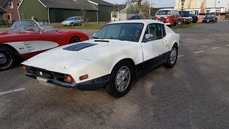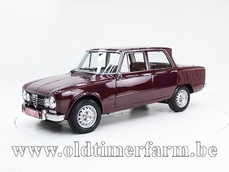Saab 97 Sonett II/III III '70 1970
General description :
Belgian papers
Beautiful car in fantastic condition
Spare no expense or effort restauration, very rare for this model
Rare color
Car is in good condition and is ready to use
As the automaker's current advertising will remind you, Saab cars were "born from jets"; in fact, the company's name is an acronym for Svenska Aeroplan Aktiebolaget, or Swedish Airplane Company. This unusual foundation for a car manufacturer set the stage for outside-the-box thinking and a focus on efficient, performance-minded engineering. With their tough little 93s proving themselves on rally stages around the world, Saab's engine development engineer Rolf Mellde, himself a racer, convinced company bosses to design a rally-ready sports car using the 93's lauded 748cc, two-stroke three-cylinder engine. The result was the Sonett Super Sport, a 57.5hp, 1,100-pound two-seater with an aluminum box-section chassis cloaked in a simple, beautiful fiberglass body drafted by Swedish industrial designer Sixten Sason. Within months, the introduction of the Group 3 racing category allowed the standard 93 to compete in modified form, rendering the impractical roadster unnecessary; only six were built.
It would be 10 years before another two-seat Saab sports car would enter production, and like its predecessor, the Sonett II shared its mechanical components with the contemporary 96 sedan. Considered "Project 97," this 149-inch-long car used an 85-inch wheelbase and was powered by the 850 Monte Carlo's 847cc two-stroke, three-cylinder engine with triple side-draft Solex carburetors making 60hp at 5,200 rpm. Gearing was provided by a four-speed manual with freewheeling capabilities and a column shifter, again a component from the sedan.
The Sonett II exemplified Saab's aeronautic-honed focus on aerodynamics, and its low-slung fiberglass fastback body was built over a welded steel chassis. It featured a large wrap-over rear window and Kamm-style tail, and in combination with the sloping one-piece front clip, this styling treatment offered an excellent 0.35 drag coefficient. Inside, the coupe featured an exposed internal roll bar, one-piece fiberglass shell seats and sporting instrumentation. The 1,565-pound Sonett got a power boost courtesy of Ford of Germany midway through the 1967 model year, when it adopted that company's single-barrel Solex-carbureted, 1,498cc, 60-degree V-4 engine.
Although the V-4 infused Saab's sports car with newfound torque and freed its owners from having to purchase two-stroke oil, its packaging meant that the Sonett required a new, awkwardly bulged hood, a change that didn't improve on what some felt was an already awkward design. Saab took this into consideration when planning the II's replacement, which would arrive for the 1970 model year.
While the price remained the same, the Sonnet III's V-4 received a different crankshaft for 1971; the 90mm stroke was complemented by a new 66.8mm bore, and with 8.0-compression, the engine made 65 DIN-rated hp at 4,700 rpm and 85-lbs.ft. of torque at 2,500 rpm. With a 4.67:1 final drive ratio, the little sportster could hit 60 mph in 11.5 seconds and top 105 mph. Other changes for 1971 included a standard steering hub-actuated horn (moved from a stalk) and side-impact door beams, while "CoolAir" air conditioning became optional.
Specifications
Bodywork
Length: cm (in): 390 (153.5)
Width: cm (in): 150 (59.1)
Height: cm (in): 119 (46.9)
Wheelbase: cm (in): 215 (84.6)
Weight: kg (lb): 800 (1766)
Mechanics.
Displacement: V 4 1699 cc (104 cu in), front-mounted
Valve gear: 8
Fuel system: 1 Au carburettor
Gearbox: 4-speed manual
Driven wheels: rwd
Maximum power: 75 hp at 5000 rpm
Maximum torque: 127 Nm at 2500 rpm
Maximum speed: 161 km/h (100 mph)
http://www.oldtimerfarm.be/en/collection-cars-for-sale/3736/saab-sonett-iii-70.php
1970 Saab 97 Sonett II/III III '70 is listed sold on ClassicDigest in Aalter by Oldtimerfarm Dealer for €16950.
Car Facts
Car type : Car Make : Saab Model : 97 Sonett II/III Model Version : III '70 Engine size : 0.0 Model Year : 1970 Sub type : Coupé Location : Aalter
Sold
Seller Information
Sold
People who viewed this Saab 97 Sonett II/III also viewed similar Saab listed at ClassicDigest
Other cars listed for sale by this dealer
About Saab
Saab, originally an acronym for Svenska Aeroplan Aktiebolaget (Swedish Aeroplane Company), began its journey as an aircraft manufacturer in 1937. Founded in Sweden, Saab's primary focus was on producing fighter planes and military aircraft. Over time, the company diversified its interests and ventured into automobile manufacturing, which eventually led to the creation of quirky yet innovative cars that stood out in the automotive industry.Fighter Plane Manufacturing:
Saab's history in the aviation industry was marked by its production of innovative fighter planes. One of its most iconic aircraft was the Saab 29 Tunnan, introduced in the early 1950s. The Tunnan was notable for its unique design, featuring a barrel-shaped fuselage, which earned it the nickname "The Flying Barrel." It was powered by a single jet engine and became Sweden's first domestically produced jet-powered fighter aircraft.
Following the success of the Tunnan, Saab continued to develop advanced military aircraft. The Saab 35 Draken, introduced in the late 1950s, was another milestone for the company. The Draken was a delta-winged interceptor known for its remarkable speed and distinctive double-delta wing configuration. Its innovative design allowed for excellent maneuverability and performance, making it a significant asset in Sweden's air defense arsenal for several decades.
Transition to Automobile Manufacturing:
In the late 1940s, Saab expanded its operations into the automotive industry. The company's first foray into car manufacturing resulted in the production of the Saab 92, which debuted in 1949. The Saab 92 was a compact and aerodynamic car powered by a two-cylinder, two-stroke engine. Its unconventional design, with a streamlined shape and front-wheel-drive layout, set it apart from other cars of its time.
As Saab continued to innovate, it introduced several notable models in the automotive market. The Saab 99, launched in the late 1960s, was a significant milestone for the company. It featured distinctive styling, including a wraparound windshield and a unique "hockey stick" profile, giving it a recognizable appearance. The Saab 99 also introduced technical advancements such as turbocharging, enhancing performance and fuel efficiency.
The evolution continued with the Saab 900, introduced in the late 1970s, which became one of the company's most iconic models. The Saab 900 was known for its robust build quality, innovative safety features, and unconventional design elements, including the signature wraparound windshield. It offered turbocharged engines and a versatile hatchback body style, catering to a niche market seeking individuality and practicality.
Technical Aspects and Quirks:
Saab cars were characterized by their technical innovations and unique features. Some of the standout technical aspects and quirks of Saab automobiles include:
Turbocharging: Saab was one of the pioneers in popularizing turbocharged engines in passenger cars, significantly enhancing power output without sacrificing fuel efficiency.
Safety Innovations: Saab prioritized safety and introduced various safety features, including reinforced passenger compartments, impact-absorbing structures, and advanced braking systems.
Aircraft-Inspired Design: The company incorporated design elements inspired by its aviation heritage, such as aerodynamic shapes, wraparound windshields, and unconventional styling cues.
Ergonomics and Practicality: Saab cars were known for their comfortable interiors, innovative ergonomics, and practical features like the ignition key placement between the front seats.
Quirkiness: Saab cars often featured unconventional design choices and solutions, appealing to a niche audience seeking something different from mainstream automobile offerings.
Saab's journey from a renowned fighter plane manufacturer to a builder of quirky yet innovative cars highlights its commitment to innovation, unique design, and technological advancement in both the aviation and automotive industries. Despite facing challenges and changes in ownership over the years, Saab's legacy endures through its distinct and unconventional approach to vehicle design and engineering.









